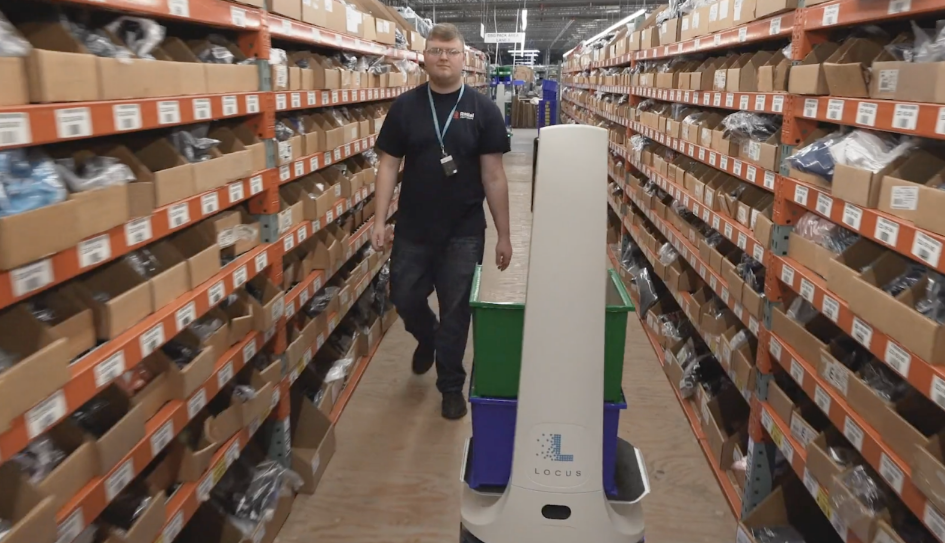WP: How to achieve 400 UPH with Locus Fast Pick
WP: How to achieve 400 UPH with Locus Fast Pick Download Now!
5 Benefits of Human-Robot Partnerships in Warehouses
Rob Press, Content Marketing Mgr. at Deputy

In the supply chain, warehouses play a crucial role in receiving products from the source, storing them safely, and delivering them quickly and efficiently. In recent years, the increased use of automation and robotics has transformed warehouse operations by delivering substantial efficiency, safety, and precision improvements. This collaborative human-robot partnership capitalizes on the respective strengths of humans and robots to achieve even more significant productivity benefits that also include increased safety and improved workplace quality.
As the use of robotics and automation continues to expand, it is becoming increasingly crucial for businesses to understand the advantages of human-robot partnerships in the warehouse. It is especially true given the continued growth of ecommerce, which has increased the demand for faster, more efficient fulfillment. According to a recent report from MarketsAndMarkets, the global warehouse robotics market is expected to grow at a compound annual growth rate (CAGR)of over 16% between 2021 and 2026.
In light of these facts, it is evident that the human-robot partnership is an important subject that deserves the attention of businesses seeking to enhance warehouse operations.
1. Enhanced safety
The human-robot partnership in the warehouse provides a safer working environment by reducing the number of hazardous tasks that employees perform. Automated systems and robots can take over many of these tasks, reducing workplace injury risk.
The warehousing industry accounts for 8% of 2.8 million nonfatal work-related injuries a year! The humans-robots partnership eliminates manual handling—the leading cause of workplace injuries—and prevents repetitive stress injuries such as carpal tunnel syndrome and tendonitis.
In addition, using robots in the warehouse reduces the risk of falls, trips, and slips and increases visibility, thereby reducing the likelihood of collisions and other safety risks. The use of robots and automation enhances safety and fosters a more positive work environment.
2. Enhanced productivity
Productivity enhancement is one of the primary benefits of human-robot partnership. According to a study by Deloitte, human-robot partnership can increase the speed and precision of routine operations and productivity, especially in warehouses and manufacturing.
Partnerships between humans and robots have the potential to increase productivity through faster and more accurate order fulfillment. Automated systems can process and handle orders significantly faster than human employees, reducing the time required to complete tasks.
In addition, robots can help to reduce human error in order fulfillment processes, enhancing accuracy and decreasing the need for manual corrections. Higher accuracy saves time and reduces the likelihood of customer dissatisfaction and product returns.
Human-robot partnerships significantly increase warehouse productivity by automating routine and repetitive tasks. These partnerships can help businesses remain competitive and meet the demands of a constantly evolving market.
3. Enhanced flexibility
Another major advantage of human-robot partnerships in the warehouse is enhanced flexibility. Companies can program automated systems and robots to perform various tasks, making it easier for businesses to respond to new challenges.
Using programmable robots easily reconfigured to perform new tasks increases the adaptability and versatility of partnerships between humans and robots. This enables businesses to respond swiftly to demand and business priority changes without extensive retraining, new capital expenditure (CapEx), or recruiting new employees.
In addition, robots can operate 24/7, allowing businesses to increase production capacity and decrease order fulfillment times. This eases the efforts required for logistics staff scheduling and makes operations more flexible. Such flexibility is advantageous during peak demand periods such as holidays and other busy times when hiring additional labor can be difficult.
Partnerships between humans and robots can help businesses stay ahead in a rapidly-changing market and meet customer demands by providing increased flexibility and the ability to adapt quickly to changing business conditions.
4. Increased human capital utilization
Human-robot partnerships in the warehouse provide numerous benefits, including increased human capital utilization. By automating repetitive and low-value tasks, human workers can concentrate on higher-level activities requiring creativity, critical thinking, and problem-solving skills.
It can redirect humans from physically demanding and repetitive tasks such as pulling a heavy cart through a warehouse or continually bending over to lift an item off a truck to more strategic tasks such as quality control, warehouse maintenance, customer service, and inventory management. This not only improves the utilization of human workers' skills but also fosters innovation and helps businesses remain competitive.
Human-robot partnerships can help companies stay ahead of the curve and remain competitive in a rapidly changing marketplace by enhancing the utilization of human capital. By combining the strengths of humans and robots, businesses can achieve better results and allocate their resources more effectively.
5. Enhanced customer service
Customers demand accurate, dependable, and prompt delivery of their orders. By utilizing robots, warehouses can optimize their operations better and increase speed, resulting in more accurate and timely delivery. According to a study by the Boston Consulting Group, robots can increase warehouse picking productivity by up to 55%. In the end, this results in increased customer satisfaction.
In addition, human-robot collaborations can improve the precision of order fulfillment. Robots can perform repetitive tasks with greater accuracy and consistency than humans, reducing the likelihood of making mistakes. This results in fewer returns and exchanges, which also increases customer loyalty and satisfaction.
By optimizing operations and enhancing order fulfillment, human-robot alliances can result in enhanced customer service, which is essential for retaining and expanding customer relationships.
Conclusion
Human-robot partnerships have the potential to revolutionize the way warehouses operate, delivering a wide range of benefits, including improved safety, increased productivity, enhanced flexibility, better utilization of human capital, and improved customer service. By automating many dangerous and repetitive tasks in handling goods, warehouses allow human workers to concentrate on higher-value activities, improve overall safety, and foster a more conducive work environment.
Partnerships between humans and robots have obvious advantages, and their benefits are substantial. Integrating human and robot skills can help companies improve their operational speed, accuracy, and safety, ultimately delivering better outcomes for all stakeholders. As technology advances, we can expect to see even more opportunities for collaboration between humans and robots in the warehouse.
About the Author
Rob Press is a content marketing manager at Deputy, a robust scheduling software that can be used to manage your workforce in a wide variety of different industries. Aside from helping businesses reach operational efficiency, he keeps up to date with the latest trends in SaaS, B2B, and technology in general.




